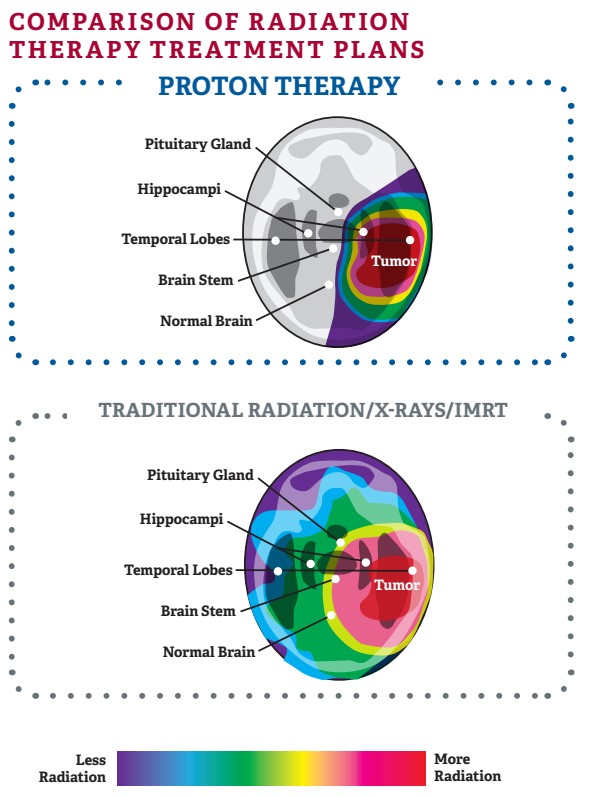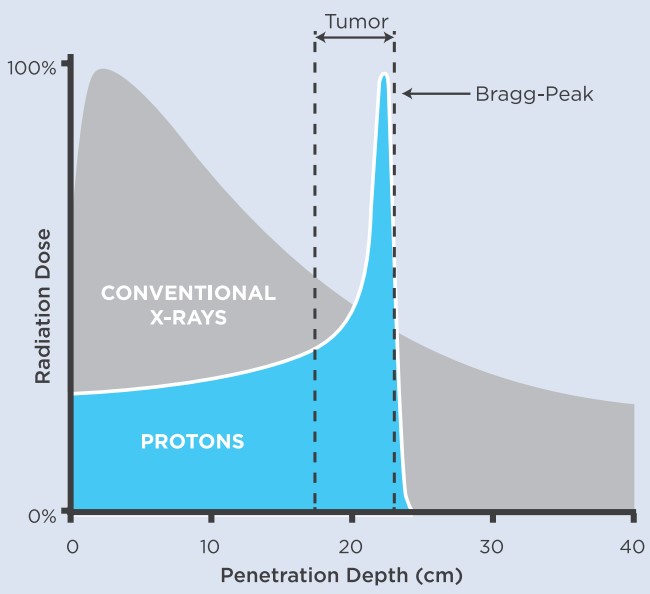Proton therapy for pediatric cancer treatment
- Maintains quality of life
- Lower risk of side effects
- Decreased impact on surrounding tissue
- Reduced radiation exposure
- Controlled placement & dosage
- Treatment of complex tumors
- Treatment near sensitive organs
Precise Cancer Treatment
Pediatric cancer treatment that improves your child's survival odds and improves their quality of life for the long term
Finding out your child has cancer is a heartbreaking experience but that doesn’t mean there isn’t hope. Advances in treatment options and protocols means we’re able to offer exceptionally effective cancer treatment that substantially improves outcomes for kids while simultaneously ensuring minimal side effects due to the ultra-precise nature of proton therapy.
Traditional radiation treatment uses beams of energy that pass through the human body to the tumor. Unfortunately with traditional radiation therapy, some of that energy travels through the tumor into healthy tissue. That extra radiation is called the “exit dose,” which negative affects healthy tissue as it exits the body.
Proton therapy, in contrast, can be modulated to stop precisely at the far edge of the tumor thus producing a very low exit dose. This is called the Bragg-Peak. This greatly reduces unnecessary radiation resulting in fewer treatment-related side effects.
A care coordinator will contact you by phone during normal business hours.
Proton Therapy for Pediatric Cancer
Precise Cancer Treatment
Pediatric cancer treatment that improves your child's survival odds and improves their quality of life for the long-term
Finding out your child has cancer is a heartbreaking experience but that doesn’t mean there isn’t hope. Advances in treatment options and protocols means we’re able to offer exceptionally effective cancer treatment that substantially improves outcomes for kids while simultaneously ensuring minimal side effects due to the ultra-precise nature of proton therapy.
Traditional radiation treatment uses beams of energy that pass through the human body to the tumor. Unfortunately with traditional radiation therapy, some of that energy travels through the tumor into healthy tissue. That extra radiation is called the “exit dose,” which negative affects healthy tissue as it exits the body.
Proton therapy, in contrast, can be modulated to stop precisely at the far edge of the tumor thus producing a very low exit dose. This is called the Bragg-Peak. This greatly reduces unnecessary radiation resulting in fewer treatment-related side effects.
A care coordinator will contact you by phone during normal business hours.
Proton Therapy for Pediatric Cancer

How Proton Therapy works
Proton Therapy is delivered using a purpose-built machine called a cyclotron or synchrotron that accelerates proton particles directly to a tumor or other areas of concern for microscopic tumors.
Traditional radiation therapy delivers photons or x-rays that pass through the body to the tumor site while continuing on though healthy tissue to finally exit the body. This unfortunately causes healthy tissue to be irradiated in the process of treatment causing adverse side effects including potentially new tumors.
Proton Therapy is far superior to traditional radiation therapy due to its ability to be manipulated so precisely that the desired radiation dose can be delivered while ensuring it stops at the tumor site.
The unique and ultra-precise delivery property of protons is known as the Bragg-Peak (pictured below). In essence, with Proton Therapy technology, we can deliver the desired radiation dose to the tumor with virtually no radiation reaching the surround healthy tissues.

Why Proton Therapy is ideal for pediatric patients
Because children’s bodies are still developing and growing, they can have more serious short-term and long-term effects from more primitive x-ray radiation than adults.
While adults benefit greatly from the precision of Proton Therapy, Proton Therapy is generally even more ideal for treatment of solid tumors in children because it delivers far less radiation to healthy surrounding tissue. This greatly helps prevent short-term and long-term effects but also more serious complications in their still-developing bodies.
Proton Therapy delivers less radiation to the heart, lungs, abdomen and esophagus for pediatric patients with medulloblastoma. Less radiation to these critical organs reduces the likelihood that patients will experience adverse effects years after treatment.
Research shows that Proton Therapy can reduce the risk of developmental and growth delays and abnormalities, reductions in IQ and other issues often linked with standard x-ray radiation. This is why Proton Therapy is often preferred when children need radiation treatment.

Reducing cancer risk later in life
Developing treatment-related cancer later on in life is a risk from cancer treatment like chemotherapy and radiation due to the less precise nature of these treatments. The risk is small but given the long post-treatment life expectancy of pediatric patients, it benefits our patients to ensure we do everything we can to minimize the risks over the long run.
Studies show that proton therapy reduces the likelihood of developing treatment-related cancer by half due to Proton Therapy’s ability to deliver radiation precisely to the tumor while avoiding the healthy surrounding tissues.
We treat a variety of pediatric tumors with proton therapy including but not limited to:
- Central Nervous System tumors (including medulloblastoma ependymoma, neuroblastoma, germinoma, and primitive neuroectodermal tumors)
- Benign tumors (such as craniopharyngioma)
- Chordomas and tumors of the base of skull
- Hodgkin’s lymphoma and other lymphomas
- Retinoblastoma
- Sarcomas (including bone sarcoma, Ewing’s sarcoma, rhabdomyosarcoma, and osteosarcoma)
Every day, the outlook for kids with cancer becomes more promising. According to the American Cancer Society, about 80% of kids with cancer are surviving at least five years past their diagnoses.


We have answers to your questions
Typically, there is no pain, discomfort, or sensation during the actual radiation treatment. Fortunately, most pediatric patients have few, if any, mild side effects from proton therapy. These can easily be managed with medication in most cases.
The actual treatment process only lasts about one minute but the entire pediatric cancer treatment session can range from 20 minutes to 90 minutes depending on the patient’s needs and case. Sedation is an option if the child needs help sitting still during the treatment.
Due to the mild and precise nature of proton therapy, children are able to participate in normal life and activities before and after treatment.
Our care coordinators are happy to share more. Please call or reach out to us using the contact form.
Yes! There are many American and international clinical studies that prove the effectiveness of Proton Therapy including the three studies mentioned below on this page. We’re happy to provide even more information, please reach out to us and we’ll be happy to share more.
Yes! Of course, each case is different and a treatment plan customized to meet the patient’s needs must be implemented but Proton Therapy can be used in conjunction with conventional radiation, chemotherapy, hormone therapy, and/or as a follow-up to surgery.
Yes! Many private insurance companies in addition to Medicare and state Medicaid programs cover Proton Therapy. We understand you have many questions regarding not only treatment but also cost. Our financial coordinators are here to help you understand your insurance coverage, your own out-of-pocket costs, and even help find alternative financing options if needed.
Not at all! Proton therapy was approved by the U.S. Food and Drug Administration 36 years ago in 1988. To date, there have been more than 105,000 patients treated with Proton Therapy worldwide. This makes Proton Therapy a widely trusted and proven treatment option.
Cancer treatment with protons compared to treatment with conventional radiation/X-rays/IMRT
Protons can be controlled with greater precision than X-rays. This means that more energy goes into destroying the tumor and less radiation is delivered to surrounding healthy tissue.
For this reason, proton therapy is particularly good for treating tumors near healthy organs, including pediatric tumors.

What is proton therapy?
Proton therapy uses charged particles (protons) rather than x-rays to selectively destroy cancer cells. This results in excellent rates of cancer control with a much lower risk of side effects compared with other forms of radiation therapy.
What makes proton therapy different?
Proton therapy is a highly advanced and extremely precise form of radiation. The physical properties of protons, described by the Bragg-Peak (Figure 1 down below), and the increased conformality of pencil beam scanning make it possible to spare healthy surrounding organs from unnecessary radiation exposure during treatment.
Why is this important?
When treating breast cancer with proton therapy, surrounding tissue and vital organs such as the heart and lungs are exposed to far less radiation than standard therapy. Therefore, people treated with proton therapy experience fewer side effects and an improved quality of life during and after treatment.
Is proton therapy effective?
Yes! Many clinical studies have demonstrated the effectiveness of proton therapy for treating many types of cancer.
Less radiation, better quality of life
Proton therapy deposits less radiation dose before reaching the tumor, then deposits the prescribed dose within the tumor, and has no exit dose.
X-ray radiation must start with a higher dose that gradually declines to the prescription dose at the tumor, then continues to deposit radiation in healthy surrounding tissue as it exits the body.

Committed to our cause since 1985
The Thompson Cancer Survival Center Story
World-Class treatment, right in Knoxville, TN
Thompson Proton Center is one of less than 50 proton centers in the entire world. And, we’re proud to be members of Thompson Cancer Survival Center, where leading cancer specialists use the most advanced technologies and treatment methods to achieve breakthrough successes. Our network of cancer care providers are supported by a team of patient navigators, oncology pharmacists, dietitians, genetics counselors, clinical trials experts, physicists, therapists, technologists, and nurses with one goal: to treat and beat your cancer.
Our leading oncologists
You’re in good hands with Thompson Proton Center

Radiation Oncologist
and Medical Director
Ryan Grover, MD
Residency:
Radiation Oncology
Loma Linda University Medical Center
Medical School:
University of Southern California

Radiation Oncologist
Brion Shin, MD
Residency:
Radiation Oncology
Loma Linda University Medical Center
Medical School:
Loma Linda University Medical Center

Radiation Oncologist
Allen Meek, MD
Residency:
Radiation Oncology
Johns Hopkins University
Medical School:
Johns Hopkins University
- Fill in our quick form
- A care coordinator will contact you by phone during normal business hours.
- We’ll take the time to listen and plan the next steps
A care coordinator will contact you by phone during normal business hours.

